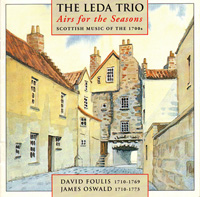
CD: Eighteen tracks of music
with a 12 page book of notes
The Edinburgh based Leda Trio plays rare, interesting and beautiful music from 18th century Scotland - music that would have been an important part of social life in Edinburgh at that time. David Foulis (1710-1773), an Edinburgh physician who died in obscure poverty, composed six sonatas over a number of years, published in a very scarce edition. James Oswald (1710-1769), in contrast, became an established professional musician and composer to George III, ending his life a wealthy man with many published compositions to his credit. The album includes three of the Foulis Sonatas - Sonata II in F major, Sonata III in E Major and Sonata V in A Major and a number of pieces from Oswalds Airs for the Seasons - The Lilac, The Nightshade, The Sneezewort and The Narcissus.
David Foulis: Sonata III Allegro in E Major
James Oswald: The Narcissus
David Foulis: Sonata III in E major
or James Oswald: The Narcissus
on springthyme/ soundcloud
Peter Campbell-Kelly: violin; Katherine Thomson: harpsichord; Kevin McCrae: cello.
'Delightful collection, elegantly performed. A perfect introduction to the riches of this period of Scottish composition' EARLY MUSIC REVIEW
|
Track List
|
| Foulis: SONATA III in E major 8.34 1: Allegro 2: Largo/ 3: Allegro non troppo |
| 2: Largo |
| 3: Allegro non troppo |
| 4: Oswald: THE LILAC 3.38 4a: Largo/ 4b: Gavotte/ 4c: Jig (or Giga) |
| 5: Oswald: THE NIGHTSHADE 3.56 a: Aria/ b: Sostenuto/ c: Hornpipe |
| Foulis: SONATA V in A major 7.04 6: Adagio |
| 7: Allegro |
| 8: Allegro ma non troppo |
| 9: Oswald: THE LILY 3.25 a: Aria/ b: Allegro/ c: Adagio/ d: Amoroso |
| 10: Oswald: THE SNEEZEWORT 2.33 a: Amoroso/ b: Pastoralle |
| 11: Oswald: THE NARCISSUS 3.00 a: Air/ b: Jig (or Giga) |
| Foulis: SONATA II in F major 9.05 12: Non troppo Allegro 5.01 |
| 13: Adagio 1.24 |
| 14: Allegro moderato 2.34 |
Ê
TOP OF PAGE
© Springthyme Records 1997 - 2005
THE SCOTTISH ENLIGHTENMENT in the mid-eighteenth century produced figures of international stature, ranging from the philosophers, David Hume, Thomas Reid and Adam Smith, to the painter Allan Ramsay, the architect Robert Adam, the medical pioneer William Hunter, the novelist Tobias Smollet, the poet James Thomson and the poet and collector of Scottish songs Allan Ramsay (senior). The Leda Trio's programme contains examples of the kind of music which was a part of all their lives, written by two Scottish composers who were themselves products of that intellectual and artistic flowering.
Allan Ramsay (senior) knew James Oswald personally and lamented in verse his emigration to London in 1742. Oswald set several poems of Smollet's to music and the two men almost certainly met in London where Oswald was a music publisher. Oswald will likewise have known James Thomson whose poem The Seasons may have played a small part in inspiring Oswald's sequence of ninety-six Airs For The Seasons from which all his works presented here have been drawn. He is also bound to have known Allan Ramsay the painter, for they both received royal appointments at the succession in 1761, as did Robert Adam in 1762.
David Foulis was by profession a physician and would have been known to William Hunter a leading Edinburgh anatomist, and Allan Ramsay (senior) would certainly also have known Foulis as they were both members of the Edinburgh Musical Society. A mutual acquaintance of Foulis' and Oswald's will have been John Armstrong, physician, poet and friend of Thomson's.
But while James Oswald and David Foulis were exact contemporaries (probably overlapping as members of the Edinburgh Musical Society in the late l730s, and were both products of the Enlightenment, they were essentially different as creative artists. Oswald was a professional musician, Foulis an amateur: Oswald composed for several genres, often incorporating elements of the Scottish idiom, Foulis composed only for violin and continuo and appears to have allowed himself no Scottish influence, whereas his Scottish contemporaries frequently declare their Scottish musical origins.
DAVID FOULIS (1710-1773)
David Foulis was born into a distinguished family. He became a physician, commencing his studies in 1729 in Edinburgh (where Armstrong was a fellow student) at what was the first Faculty of Medicine in the British Isles, and continuing at Leyden and Rheims. He returned to Edinburgh, passed his examinations to become a fellow of the Royal College of Physicians in 1737, and in 1741 was appointed Physician to George Heriot's Hospital, a charity school. He appears to have lost favour with his family after his marriage, ending his life in impecunious circumstances, depending upon the charity of his fellow professionals and failing to inherit anything of the family's substantial property.
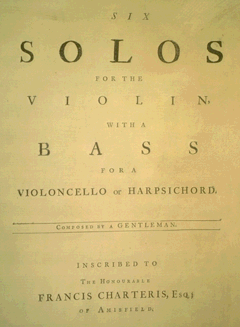 Foulis' six sonatas seem to have been written over a long period and in a different order from that published. They appeared anonymously as Six Solos for the Violin 'Composed by a Gentleman', but more than one copy of the very scarce publication has a contemporary ascription of them to him. The date of publication is thought to be around 1770 and the sonatas are dedicated to Francis Charteris of Amisfield, probably an old family friend, and certainly a fellow member of the Edinburgh Musical Society from 1741 onwards. Although the cover of the publication describes the works as 'Solos', they are individually titled 'Sonata', the Italian rather than English term.
Foulis' six sonatas seem to have been written over a long period and in a different order from that published. They appeared anonymously as Six Solos for the Violin 'Composed by a Gentleman', but more than one copy of the very scarce publication has a contemporary ascription of them to him. The date of publication is thought to be around 1770 and the sonatas are dedicated to Francis Charteris of Amisfield, probably an old family friend, and certainly a fellow member of the Edinburgh Musical Society from 1741 onwards. Although the cover of the publication describes the works as 'Solos', they are individually titled 'Sonata', the Italian rather than English term.
- Ê
- Foulis must have studied music to reach the proficiency that he did as a composer, though all that is known of his music is this publication and a Minuet and March. His writing for violin is excellent and we may guess that he understood and could play the instrument to a high standard. As a member of the Edinburgh Musical Society in the 1740s he was expected to be a performer, and he would have played alongside William McGibbon a fellow member who was probably the most accomplished British violinist of his day.
- Ê
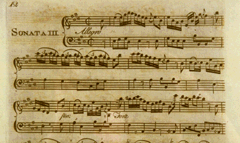 THE FOULIS SONATAS
THE FOULIS SONATAS
- The SONATA III in E major is in the shape of a Neapolitan Sinfonia with an opening Allegro, a central Largo in the tonic minor and final Allegro non troppo. The Allegro is cast in a miniature sonata form, with a bold first subject and brief development in the dominant. The Largo is a particularly good example of Foulis' natural melodic gifts. The use of expressive double stops adds intensity to the gently flowing pastoral character of the movement, which is a siciliano. The Allogro non troppo has much of the elegance of a minuet, and the sonata as a whole is bright and tuneful.
- Ê
- The A major SONATA V is also in three movements, but the first is an introductory Adagio in which Foulis has broken away from the usual four bar structure, in favour of three five-bar phrases. The central Allegro, in sonata form, makes effective use of contrasting passages in the minor, but ends with lively arpeggio passage work. The final Allegro ma non troppo is similar to that of the third sonata. Here again Foulis varies the usual phrase patterns, enhancing the shapeliness of the violin writing.
- Ê
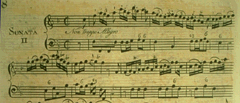 The SONATA II in F major is thoroughly pastoral in character. The first movement is marked Non troppo also and here, and in the beautiful through-composed Adagio which follows, the bass line is given frequent points of rest on one note. The gentleness is underlined by the choice of the subdominant key for the Adagio, and the last movement is an Allegro moderato in sonata-rondo form with an interesting extended episode in the minor.
The SONATA II in F major is thoroughly pastoral in character. The first movement is marked Non troppo also and here, and in the beautiful through-composed Adagio which follows, the bass line is given frequent points of rest on one note. The gentleness is underlined by the choice of the subdominant key for the Adagio, and the last movement is an Allegro moderato in sonata-rondo form with an interesting extended episode in the minor.
- Ê
- As a whole these sonatas offer an insight into the early stages of the development of classical form, the first being in the old baroque, four movement format. But they are also expressive examples of a delicacy of feeling and refinement of expression which go well with the society for which they were written, but which raise the music above the conventional niceties of the day and deserve a lasting place in the repertoire.
- JAMES OSWALD (1710-1769)
- James Oswald started his career as a dancing master in Dunfermline in the early 1730s. He was also a cellist, violinist, music teacher, publisher and composer, active in Edinburgh from 1736, and moving to London in 1741 where he rose to the height of his profession, becoming Chamber Composer to King George III in 1761, and ending his life a wealthy man in his own right as well as spending his last days in the splendid Knebworth House which his second wife had inherited. An early notebook from 1734 shows that he studied and imitated the Italian style of composition, as well as cultivating his own native music.
- Ê
- His works included two satirical Cantatas, Masonic vocal trios published in Edinburgh in 1740, pieces for guitar solo and duet. Besides these, there are Six Pastoral Solos, Twelve Serenatas, Fifty-five Marches, a Sonata on Scots Tunes, and The Caledonian Pocket Companion - a fifteen volume collection of Scots songs and tunes made by Oswald, some of them traditional and others composed by himself and his Airs for the Seasons in two volumes.
- Ê
- AIRS FOR THE SEASONS
- Oswald's Airs for the Seasons commenced publication in 1755 in parts as Airs for the Spring - and so on for Summer, Autumn and Winter, and they were so successful that he put together a second set intended to follow on from the first, as the page numbers indicate. As each season has twelve 'Airs', bearing the title of a flower, shrub, or tree, this makes the remarkable total of twice forty-eight pieces, representing ninety-six different plants. However, the second set survives in only a single copy (in the Wighton Collection in Dundee City Library).
- Ê
- Oswald was a miniaturist and each work is designed to fit onto one side of a sheet (they may have been available separately): but in many cases there are two or more movements, the last often being a dance, so one might be tempted to describe them as sonatas. Oswald quoted a Horace Ode on the cover - 'Now Venus leads the dance' and the handsome illustration shows her with Cupid above and the three Graces and two nymphs dancing with a chain of flowers. Enfolding them all in his cloak is a man quaintly adorned with ruffed collar and broad-brimmed hat, perhaps representing Oswald himself in old-fashioned rustic garb. Whether or no, the quotation is an explicit claim for the Scottish dancing-master to make, placing himself directly in that classical tradition which, in Horace, exemplified the marriage of nature and art, but evoking the Goddess of Love as the source of his inspiration. The Horace, however, ends with the death of Lycidas (the ideal of the shepherd with his pipe), and the Oswald carries Winter in the implication of Spring (it was Winter which first inspired Thomson and Armstrong) - but whether this has any particular meaning for the music is not clear.
- Ê
- The two sets of Airs are structured simply by the seasons and choice of plants, but there was more to this than meets the eye. The Prince of Wales (also a cellist) was himself a keen gardener, rearranging the gardens at Kew in a manner more sympathetic to the concept of 'naturalness'; and the 3rd Earl of Bute (a Scot to whom Oswald dedicated one of his publications) managed Kew for the Prince's widow. There are dear indications that Oswald used the legends and characteristics associated with a plants to determine not only the structure of individual movements, but the structure of the piece as a whole. This goes much deeper than composing a Scottish reel for the last movement of THE THISTLE, and even includes medical applications which he may have gathered from Dr. John Armstrong who was a frequent visitor at Oswald's shop, Armstrong's favourite coffee house being also in St. Martin's Lane, London. Foulis would have appreciated these connections as he had studied with Boerhaave, who was a botanist as well as Europe's most celebrated teacher of medicine.
- Ê
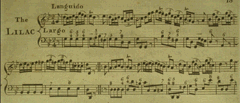 An example, from the second set for Spring, is THE LILAC which is not readily explained as illustrative of the tree or its flowers: but the plant's medicinal uses may well explain the music's distinctive characteristics. It has a sinuous first movement - a Largo in G minor, marked Languido and with an unusually static bass line for Oswald; followed by two dance movements with the cello part actively tugging at the rhythms of the violin. The first of these is a Gavotte marked Brilliante but also in G minor, the last a 9/8 jig or Giga in the major key. Clearly there has been a progression from a languid state to one of cheerful activity, and since lilac was used to dispel fevers, as a purgative and to evict worms, one does not have to think hard to appreciate the wit with which Oswald has illustrated its efficacy!
An example, from the second set for Spring, is THE LILAC which is not readily explained as illustrative of the tree or its flowers: but the plant's medicinal uses may well explain the music's distinctive characteristics. It has a sinuous first movement - a Largo in G minor, marked Languido and with an unusually static bass line for Oswald; followed by two dance movements with the cello part actively tugging at the rhythms of the violin. The first of these is a Gavotte marked Brilliante but also in G minor, the last a 9/8 jig or Giga in the major key. Clearly there has been a progression from a languid state to one of cheerful activity, and since lilac was used to dispel fevers, as a purgative and to evict worms, one does not have to think hard to appreciate the wit with which Oswald has illustrated its efficacy!
- Ê
- Ê
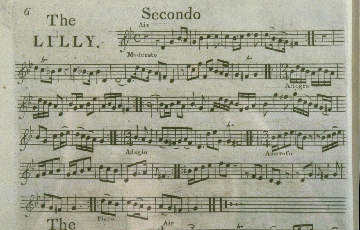 The range and scoring of most of the 'Airs' shows that they were composed for violin, cello and harpsichord; but the cover depicts a variety of instruments, including lute, flute and bassoon; and for the first set of Airs for the Spring, Oswald composed optional parts designated for a second violin or flute (as above for The Lilly Secondo). Probably the airs were expected to be adapted for whatever was available, but Oswald's renowned skill as a cellist has influenced the unfailing interest of the bass lines, which frequently share material with the upper part and perform much more than the merely supporting role common at the time.
The range and scoring of most of the 'Airs' shows that they were composed for violin, cello and harpsichord; but the cover depicts a variety of instruments, including lute, flute and bassoon; and for the first set of Airs for the Spring, Oswald composed optional parts designated for a second violin or flute (as above for The Lilly Secondo). Probably the airs were expected to be adapted for whatever was available, but Oswald's renowned skill as a cellist has influenced the unfailing interest of the bass lines, which frequently share material with the upper part and perform much more than the merely supporting role common at the time.
- Ê
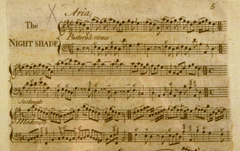 THE NIGHTSHADE (from the first set for Autumn) starts with an Aria marked Pastorale Vivace, perhaps because Nightshade is also called Belladonna as Italian prostitutes used it to make their eyes sparkle. It is certainly an appealing and bright eyed movement in D major. The Italian ports were notorious for prostitution and the central Sostenuto in B minor may be suggestive of nightshade in more than one meaning. The concluding Hornpipe, in triple rime and with lively syncopations, is thoroughly British in character, from which we may guess that the visiting sailors have had a good time of it.
THE NIGHTSHADE (from the first set for Autumn) starts with an Aria marked Pastorale Vivace, perhaps because Nightshade is also called Belladonna as Italian prostitutes used it to make their eyes sparkle. It is certainly an appealing and bright eyed movement in D major. The Italian ports were notorious for prostitution and the central Sostenuto in B minor may be suggestive of nightshade in more than one meaning. The concluding Hornpipe, in triple rime and with lively syncopations, is thoroughly British in character, from which we may guess that the visiting sailors have had a good time of it.
- Ê
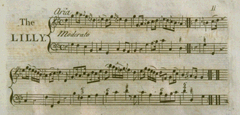 THE LILLY (spelt by Oswald with two 'l's) comes from the first set for Summer and opens with an expressive Aria. It is not clear whether Oswald means Lily-of-the-valley, the Fleur-de-lys, or Lilium candidum, but it is surely a white lily since it is entirely in G minor, implying pallor. The tendency of the phrases to droop, even in the central Allegro, may mimic the drooping flowers or pendant leaves of the lily, also symbolising humility. This would suit the final Amoroso which ends with four bars marked to be played quietly. The whole may be taken to signify pale and modest beauty.
THE LILLY (spelt by Oswald with two 'l's) comes from the first set for Summer and opens with an expressive Aria. It is not clear whether Oswald means Lily-of-the-valley, the Fleur-de-lys, or Lilium candidum, but it is surely a white lily since it is entirely in G minor, implying pallor. The tendency of the phrases to droop, even in the central Allegro, may mimic the drooping flowers or pendant leaves of the lily, also symbolising humility. This would suit the final Amoroso which ends with four bars marked to be played quietly. The whole may be taken to signify pale and modest beauty.
 THE SNEEZEWORT (spelt by Oswald as Sneez-wort) was supposed to be good for colds, as sniffing a powder made from it helped you sneeze. It is found appropriately in the second set for Autumn. The first movement is a pathetic and lugubrious Amoroso, streaming with the cold in miserable D minor chromaticisms. The second is a Pastorale - a chilly autumn hunting scene but again in the minor key and with a desperate urge to sneeze, which is not gratified until the trills near the end.
THE SNEEZEWORT (spelt by Oswald as Sneez-wort) was supposed to be good for colds, as sniffing a powder made from it helped you sneeze. It is found appropriately in the second set for Autumn. The first movement is a pathetic and lugubrious Amoroso, streaming with the cold in miserable D minor chromaticisms. The second is a Pastorale - a chilly autumn hunting scene but again in the minor key and with a desperate urge to sneeze, which is not gratified until the trills near the end.
- Ê
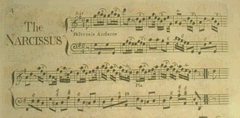 There are just two movements for the brief dancing life of THE NARCISSUS. The first one, is in the style of a Scottish air, but with reflections and echoes added because Narcissus fell in love with his own reflection and was beloved of Echo. This is a perfect example of the native and the classical in each other's arms. The second movement reflects the fact that the Narcissus was a dancer's plant. The medicine from it was good for strained sinews and stiff joints; and the Narcissus bending in the breeze leads the first dance of spring-and is his dance, the second movement, is a Scottish jig full of the cheerfulness of the season. It comes from the first set for Spring.
There are just two movements for the brief dancing life of THE NARCISSUS. The first one, is in the style of a Scottish air, but with reflections and echoes added because Narcissus fell in love with his own reflection and was beloved of Echo. This is a perfect example of the native and the classical in each other's arms. The second movement reflects the fact that the Narcissus was a dancer's plant. The medicine from it was good for strained sinews and stiff joints; and the Narcissus bending in the breeze leads the first dance of spring-and is his dance, the second movement, is a Scottish jig full of the cheerfulness of the season. It comes from the first set for Spring.
- Ê
- In asserting an exemplary purpose, often of considerable subdelty, for Oswald's Airs for the Seasons we must not lose sight of their unpretentious directness. That directness is in fact part of their purpose. They are miniatures; a posy of flowers, laid metaphorically perhaps on the altar of the Temple of Apollo; but they are not an attempt to build that temple, as the Adam family might have done. There are no Corinthian columns or grand porticos in Oswald's design, only a natural and unaffected beauty, wit and candour that form one of the most remarkable musical compendiums ever assembled.
John Purser, Glasgow
Copyright © John Purser 1994

SPRINGTHYME or TOP OF PAGE
© Springthyme Records 1997 - 2012

